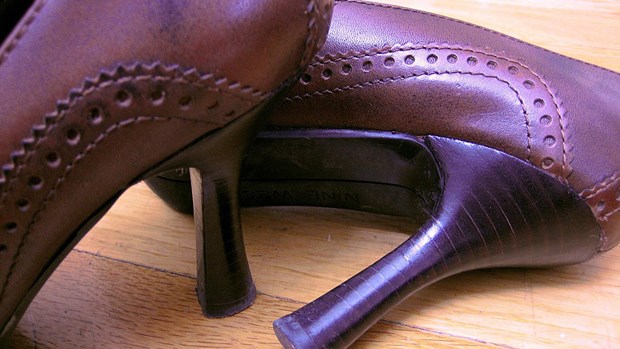Why Do People Only Notice My Clothes?

Should she be wearing those shoes to preach?
I regretted the thought as soon as it ran through my head. The preacher at the large, ecumenical conference was experienced and well-educated. The narrative of her sermon was strong, and the gospel was proclaimed. But I still couldn’t get my mind past her shoes, which, I must add, would have been appropriate in any office workplace.
Wardrobe is a tricky issue for women who preach. What seems simple for men is much more complicated for women. Costume designer Heather Leigh Brown explains why this might be:
For nearly 200 years, since Jane Austen's time, men could put on a version of a shirt, pant, tie, and coat and be “dressed up,” both presenting and concealing their personality. If the man finds himself too dressed up, the solution is simple. Take off the coat and tie, roll up the sleeves, and now he’s a man’s man. (Watch politics.) And, most men look good in the outfit. As Jane Austen might have said, “It is most unfair.”
Indeed. The only time I have paid attention to a man’s shoes while he was leading in a worship service was when I noticed that they needed repair.
What Should We Wear?
For preachers who wear the alb, this is not an issue. Rev. Charis Weathers, a Lutheran pastor, notes, “Wearing a clerical robe is so helpful because no one knows what is underneath it—and that's the theological point. The robe, in part, signifies that the person underneath it is a servant of the Lord: no more, no less. All the crap that goes along with being a woman in this judgmental culture gets squashed from the get go.”
But for those of us in traditions that don’t call for the alb, women continue to ponder how they may best dress so that the gospel is proclaimed and the congregation isn’t distracted by our shoes—or skirt, or pants. But I wonder: How much of the distraction is in the receiver’s mind, and how much, if any, can we mitigate from the pulpit?
Rev. Lindsay Small, Associate Director of Bast Preaching Initiatives at Western Seminary was thinking about my question when she encountered a student in the hall. The student stopped to say that her mom had seen Small preach recently. “I heard you looked fantastic,” she said. “You had a cute shift dress on.” There was not a word about the sermon, just the dress.
Small was frustrated. She explained to me,
There's a cultural reality here that is somewhat beyond our control. I do believe it is getting better for women, but culture shifts can sometimes feel like they are moving at glacial-esque speed. As a preacher, I take great care so that no one will care. I spend time on my appearance to almost become invisible. There is a narrow space between self-expression and self-deflection. And that is where I want to be. Because I want people to hear my sermon, not see my dress.
The Problem with Western Thought
The reason Rev. Small’s dress upstaged her sermon was not because she wore a dress. It was because of the way we in Western culture perceive clothing.
In After Eden: Facing the Challenge of Gender Reconciliation, Dr. Helen Sterk lists museum curator James Laver’s three principles that affect human dress: utility, hierarchy, and seduction. Sterk notes that utility “has the least effect on what people actually wear.” Men, for the most part, dress according to the hierarchy principle, and women dress according to the seduction principle.
To be clear, seduction in this context does not have to do with sex. Instead, it’s about creating social currency. Generations ago, this was done by wearing clothing that pointed to the man a woman was married to or by wearing clothing that appealed to men in higher places in society. Today social currency might better be created by dressing in a way that generates Instagram or Facebook likes.
Laver was writing in 1969 and Sterk in 1993. Though we don’t think we think in these terms, we do. Even when we have no intention of dressing in a way to seduce others, we may unknowingly respond to the dress of others through this lens.
Because we perceive women’s clothing and appearance according to the seduction principle, our acceptance of a leader partially hinges on her physical presence. So the thing we notice first: a woman’s clothing choices. It makes sense, then, why we naturally compliment women’s clothing more often than their actual message—we simply pay more attention to her clothes.
The cycle then continues when we get up to speak. We want to be liked, too, so even those of us who feel fairly content with how we look will try to look nice when we step onto the stage. But this takes away from the fact that our primary goal is for the congregation to be transformed by the gospel as we preach—not to like us because they like what we wear.
Though we have a great desire to be authentic in our dress, we cannot forget our cultural history of patriarchy and how it has and continues to objectify women in and out of the church—including us. We can’t ignore the fact that there is implicit bias that perceives a woman’s form as something to assess. This assessment follows us around and then stands in front of us when we preach. Even when we dress in a way as to be invisible, as Rev. Small put it, the people sitting in the pews will likely perceive us according to the seduction principle—simply because it is engrained in Western thought.
When We Get Frustrated
We know this is not the way it’s supposed to be. Yet we live in this tension: the tension between the already of God’s kingdom, where Jesus is reigning and the Spirit leads and guides, and the not yet of God’s kingdom, where our bodies continue to be a distraction, even when we try our darndest to mitigate it.
We don’t want to negate the body! We want to honor our embodied selves. We want to model for our body-obsessed culture what it means to live as image bearers.
To do this well, we must willingly speak about this challenge at appropriate times, calling out this harmful dynamic. Other times, we will wisely choose to remain silent because the setting isn’t right. We must consider these thought processes as we dress, naming our own temptation to extremes—whether to negate the body altogether or to dress fully according to the seduction principle—and realizing we can only do so much to mitigate the distraction. We must work to catch ourselves when we judge other’s clothing, stopping the cycle in our own minds. And when we hear a woman’s teaching, we must intentionally compliment her on what she said rather than what she wore.
Shifting engrained thought will take time, though, so when someone compliments our dress, failing to mention our actual message, we can graciously heed our mother’s advice and simply say “thank you.”
Joy-Elizabeth Lawrence (MCS, Regent College) is a M.Div. student at Calvin Theological Seminary, a writer, a speaker, and a biblical storyteller. Find her at www.pathlightstories.com.












